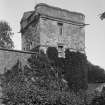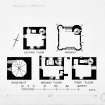Scheduled Maintenance
Please be advised that this website will undergo scheduled maintenance on the following dates: •
Tuesday 3rd December 11:00-15:00
During these times, some services may be temporarily unavailable. We apologise for any inconvenience this may cause.
Field Visit
Date 26 June 1925
Event ID 1099080
Category Recording
Type Field Visit
Permalink http://canmore.org.uk/event/1099080
Monimail Tower.
Beside the gardens of Melville House, which occupy a rising slope some 300 yards north of the mansion, is a tower ascribed to Cardinal Beaton, Archbishop of St. Andrews 1539-46. The present building is quite evidently part of a larger structure, the rest of which has disappeared. The upper part of itis dated 1578, but the lower part may possibly be earlier. Almost square on plan, it is four storeys in height. Up to the wall-head the masonry is rubble with ashlar dressings, but above that level it is ashlar. The part of the building which has disappeared, and which seems to have been three storeys high, abutted against the eastern and southern faces of the tower. On the north and west sides, which stood free, are two string-courses. On the west the upper string breaks upwards round a window head and on the north it forms a sill for an empty panel-space. The window margins are moulded with an edge-roll and quirk. The roof is flat and is enclosed by a parapet borne on a continuous corbelling, which breaks out into rounds at three of the corners, the other corner being occupied by the cap-house, which has had a pyramidal stone roof, now reduced in height. On the north-east and south-east faces of the cap-house, and on the south-east round, are roundels containing sculptured heads, the northern one representing a man in a skull cap, the southern a man with a brimmed hat. Such heads are a 16th-century convention, other examples of which occur at Falkland Palace, executed in 1537 and 1539, and at Stirling Palace of the same time. The Monimail heads are later than these, for the eastern face of the parapet bears the date 1578 with the initials of Sir James Balfour of Pittendreich, whose arms are carved within another roundel: On a chevron an otter's head erased, and in base a rose. Within a similar roundel on the opposite parapet is the quartered coat ofBethune of Balfour. The parapet has a continuous moulded cope without crenellations, and is pierced by a series of small 'gun-holes.' Internally there seems to have been a good deal of alteration. The north wall is over 6 feet in thickness and contains a newel staircase at the eastern end. Midway in its length is a kitchen flue, apparently rising either from ground level or from the ground floor, which has undergone alteration as will be seen from the plan.
The lowest storey is partly below the ground and has been adapted at a later time as an ice house, the only access to which is a hatch formed at ground-level within the flue just described. The floor, which is sloped for drainage, is not original, nor is the vaulted roof. Indeed the only feature that can be so identified is a built-up window in the west wall. At ground-level are three doorways in the north wall, all relatively modern. The eastern door gives access to the newel-stair in the northeast angle, the central one opens on the flue and hatch, and the western one, broken through the north gable, admits direct to the chamber itself. This has been a passage room, originally communicating with the main portion of the structure on south and east. The single window looks westward. There is a small fireplace on the south, a close garderobe at the south end of the east wall, and on the north the old entrance to the newel-stair, now built up. The chamber on each of the two floors above is rather broader than that at ground-level but is otherwise fairly similar, the uppermost chamber being panelled in pine in the 18th century fashion.
HISTORICAL NOTE. - The "palace" of Monimail was a country residence of the Archbishop of St. Andrews (1). In 1564 Archbishop Hamilton granted the house and lands to James Balfour (2), younger son of Balfour of Mountquhanie [NO32SW 19], afterwards Sir James and a president of the Court of Session. It was then stated that the "manor of Monimail was ruinous, waste and broken down and could not be repaired except at great cost." In 1592 Sir James sold the "palice, ludging, and maner place of Monymeill " to Sir Robert Melville of Murdocairnie (3), who was second Lord Melville [NO21SE 16] and in 1627 received the dignity of Lord Monimail.
RCAHMS 1925, visited 26 June 1925.
(1) Reg. Mag. Sig., 1587, No. 1394. (2) Earls of Melville, Sir William Fraser, i, p. 115. (3) Ibid.,iii, No. 108.













